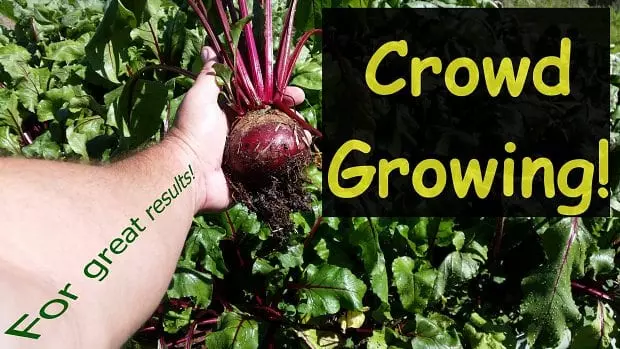We often read or hear how important spacing is when it comes to planning our backyard food crops. Seed packet instructions and the experts all tell us that plants need appropriate space if we want the best growing results.
Well, I’m going to debunk this myth and blow it right out of the raised garden bed for good and say crowding your vegetables together is not only safe to do but it might actually be better! I like to call it… Crowd Growing…
These days space is more precious than ever (especially in our cities) with properties becoming smaller and many of us living a more compacted lifestyle so we really do need to make the most out of what growing space we have in our garden. Even those of us who live on larger properties (like acreage) should seriously consider crowd growing because spacing our vegetable crops out just for the sake of it is err… a waste of space (and resources).

Crowd growing
So what is crowd growing? As the name suggests, crowd growing is planting and growing your food crops as close together as possible. In some instances this might even mean plants growing right next to each other with roots entwined sharing the same dirt!
Sounds insane hey? Not really, when you consider nature does this on her own all the time. Many types of plants are designed to grow in clusters and often nature doesn’t do a great job dispersing seed all over the place. In fact, real nature is not uniform – far from it, but that doesn’t stop plants from surviving and thriving in many cases.
Crowd growing beetroot example
Take beetroot for example, the beetroot corky type seed is actually a cluster of several seeds all in the one casing. Therefore, the “norm” for gardeners is to sow the beet seed and then thin or space the seedlings out once they have germinated otherwise the beetroot plants will grow together as a crowded cluster. The thought process behind thinning out is plants will grow better if they have less competition for food, water, and sunlight, that is, sufficient space for them to grow. This does make sense.
However, if this truly was the case why hasn’t beetroot evolved a better way to distribute its seed? Simple, because it does absolutely fine growing in clusters! Beetroot likes a crowd and it does very well in a crowded growing situation.
I rarely ever thin my beetroot seedlings out or transplant them for better spacing between plants. The only time I do is on the odd occasion if I have a gap to fill in my garden bed so I may “pinch” a few beet seedlings and bung them in. Apart from that, 99% of the time I prefer to let my beetroot grow together all crowded in as they naturally grow. I might add, beetroot is not very receptive to transplanting anyway and it does tend to suffer transplant shock more than some other plants.
Yes I know beetroot grows a large swollen root, so how does that work when the plants are crowded? In my experience, I find most plants still grow large and normal roots; of course, you do see some underperforming plants but that happens in a spaced environment also.
In a practical sense, I start harvesting my beets when they are about the size of a golf ball anyway because we like to eat baby beets and then I continue harvesting the plants as we need them until the remainder reach full size. You could say, I start thinning out later although I don’t see it like that and by the time the majority of my beet crop has reached maturity they’re still somewhat crowded.
If I were to thin the seedlings out at the early stage (when we’re supposed to) I’d have to discard most of them and many wouldn’t survive the transplant and that’s a lot of potentially lost food! But, with crowd growing I save time and actually grow more by not thinning out at the seedling stage.
Crowd growing other root/tuber crops
Most root crops do well crowded in and I have tried many, such as: carrots, potatoes, turmeric, radishes, swede, ginger, and fennel. I treat most of them exactly the same way as the beets except for maybe potatoes, turmeric and ginger where I don’t usually harvest early (you still could if you wanted baby potatoes or young ginger but I tend to crowd these crops in closer than usual and leave them grow till they’re ready for mature harvest.
Crowd growing other food crops or fruit trees
As I’ve already stated, crowd growing works for just about all food plants except for large trees, of course, although that shouldn’t persuade people from planting fruit trees closer together than usual and you’d be surprised how many fruit trees you can fit into a small suburban backyard!
As long as the trees are kept fed and pruned so they don’t overbear other trees and block out the sunlight then its happy days to plant them closer together. You’ve heard of planting two trees in the same hole? Like when two different avocadoes, or apples, are planted together to help with cross pollination? Well, that theory is very similar to crowd growing and it proves trees can share the same dirt with roots entangled and still thrive.
What are the main benefits of crowd growing?
Besides more produce and happier plants there are several other obvious benefits with crowd growing:
- Saves water – plants growing close together acts as a natural mulch and thus reduces evaporation so the plants need less water.
- Less weeds – similar to the above crowd growing lends less space for weeds to grow through the crop because there is less sunlight and more competition.
- Less waste – I touched on this before if you are not thinning seedlings out you’re keeping them so that’s good!
- Saves space – Yes, that’s pretty obvious…
Isn’t crowd growing just companion planting?
No, crowd growing can be seen as similar to companion planting or square foot gardening etc, but it really isn’t the same thing.
You can crowd grow different plants together such as a tomato and climbing bean for excellent results but not all food plants grow together well. My idea of crowd growing are mainly concerning plants of the same types – a bit like mass planting ornamentals of the same genus.
Ways to ensure crowd growing is successful
To get the best success with crowd growing in your allotment, food garden, vegetable patch, or whatever you want to call it there are some points to consider and they are:
- Plant in an open sunny position – Unless you are growing understory edible shade plants most crops do best in full sun and this is very important especially for crowd growing because by its nature plants are already competing for light.
- Plant the same variety – Like I mentioned before, you can experiment by growing some different food crops together but for the most part you want to grow the same plant close not a mix of different plants.
- Soil preparation – Well prepared soil with heaps of organic matter, manures, and fertilisers evenly dispersed throughout the bed is essential for crowd growing because you don’t want plants fighting too much for food.
- Watering – Just like nutrients, plants shouldn’t be competing for water either so don’t let them dry out.
- Crop rotation – Normally you could get a second season out of a bed with the same plants (most people do rotate every season anyway) but it is particularly important when crowd growing to rotate each crop after one season because more plants of the same type in the one bed can quickly attract pest and diseases specific to that plant variety.
Video
Here's a video about crowd growing
https://www.youtube.com/watch?v=jzPmIQDNuUQ
Conclusion
So there you have it, crowd grow your vegetables and other food crops for great results!
Remember, crowd growing works for most food crops so go ahead and experiment to your heart’s content and reap the rewards like: more produce, space saving, resource conservation, less effort, and a spectacular looking vegetable garden.
Next time you read the back of a seed packet and it says space out 40 cm go meh… and crowd grow it!
If you would like to have your say about this article make a comment below and/or join our forum – Self Sufficient Culture and let’s share tips, ask questions, and discuss things there.
Mark Valencia – Editor SSM
Look, and see the Earth through her eyes…












